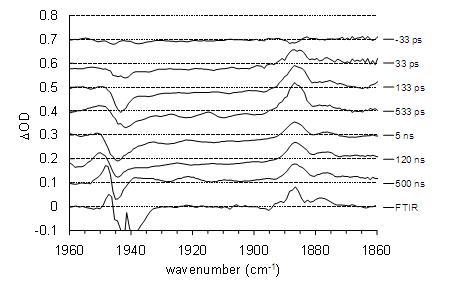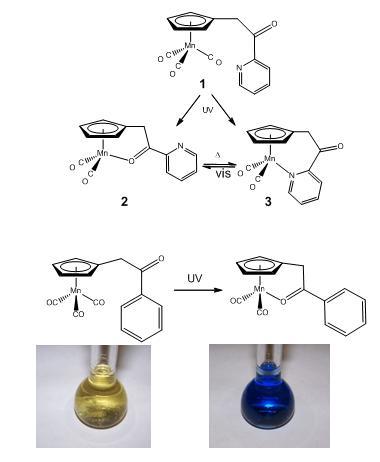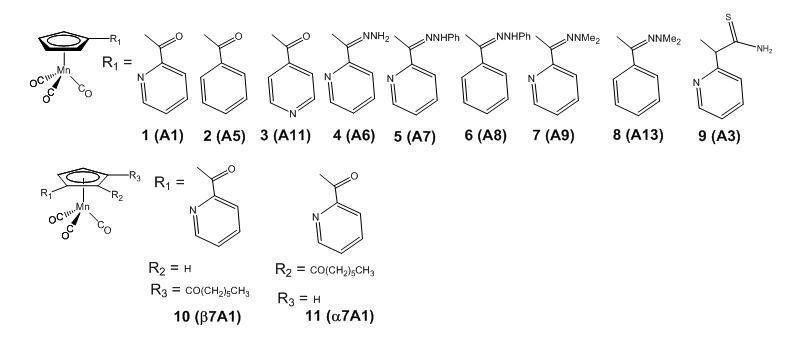Ultrafast Molecular Switch Dynamics Examined by Mid-Infrared Femtosecond Spectroscopy (Archived)
Summary
Ultrashort mid-infrared laser pulses are used to observe fast molecular and photochemical reaction processes occurring in the condensed phase. We have developed unique femtosecond broadband mid-infrared probe and detection techniques to study highly excited coherently-controlled molecular vibrational states, monitor vibrational energy transfer, measure mode-specific lifetimes during photochemical reactions, and observe the dynamics of hydrogen bond formation and rupture. These measurements help identify newly generated transient species and determine energy transfer rates which serve to improve models of condensed phase chemistry. Current directions include measurement of specifically designed bistable organometallic photo-switches optimized for reaction yields and speed. These species may eventually be used in ultrafast molecular memories, motors and related applications.
Description

Examing dynamical properties of chemical species and materials often requires measurement over many orders of time. Since early time dynamics of molecular processes occurring on the femtosecond and picosecond timescales determines their subsequent photochemistry at later times. The goal of this project is to apply in-house mid-infrared probing methods for determining vibrational population dynamics of bi-stable molecular switch species with unprecedented time and spectral resolution. Since the early demonstration of time-resolved infrared spectroscopy (TRIR) using single frequency or broadband infrared generation with 2D CCD and infrared camera detection in this laboratory (circa 1993), many other labs have pursued similar venues and approaches to examine other systems of interest. Commercial sources of femtosecond mid-IR pulses (using nonlinear OPA technology) are now routinely used to investigate a gamut of chemical reactions, materials properties and energy transfer phenomena. Other related spectroscopies have been developed using some of these principles (e.g., IR sum-frequency, 2D-IR spectroscopy) in many academic research laboratories around the world. The approach we employ involves synthesis of target organo-metallic species that first undergo internal chelation (after CO photo-ejection; using UV excitation pulses) followed by broadband mid-infrared femtosecond pulses in the 5 micron spectral region to probe intermediate species by monitoring CO-stretching populations and dynamics. TRIR Spectroscopy is accomplished using a 2D infrared camera (256x256 pixels of InSb or HgCdTe covering 2 micron to 12 micron wavelength) which monitors the transient absorption spectrum on each laser shot without frequency tuning. Femtosecond to picosecond (ca. 150 fs to 700 ps) time delay is accomplished by standard optical delay methods. Excitation with a synchronized nanosecond or secondary excitation laser source permits electronically delayed probing out to the millisecond timescale. These approaches generally include measurements of vibrational mode population decay, overtone excitation, photochemical conversion of a starting species to others, or changes in vibrational infrared spectra as a function of time. Once the photodynamics of synthetic switch species is measured new species are designed, synthesized and tested to improve yield and speed, as well as finding conditions to initiate reverse reaction dynamics (e.g., use of visible wavelengths) to form a true molecular switch. An example of a photochromic system based on a Manganese tri-carbonyl organometallic species is shown below as well as other candidate species:

Recently synthesized derivatives of 1 that also show promise as bi-stable molecular switches include:

Major Accomplishments
- First to measure CO-stretching vibrational lifetimes in metal-carbonyl species and influence of solvent on vibrational energy transfer properties.
- Developed TRIR method to monitor photochemistry of candidate organometallic molecular photoswitch species from sub-picosecond to microsecond timescales.
- Observed picosecond timescale intramolecular chelation without intermediate solvation suggesting picosecond switching dynamics is possible.
- Application of different excitation energies revealed CO-loss and excited state molecular distortions occur in these systems. Transient extension of the Fe-Fe bond length enhances CO-stretch absorption intensity but does not break the bond.
- Applied discovered dynamical properties of test species towards synthesis of bi-stable targets through collaboration with Prof. Theodore J. Burkey, Chemistry Department, The University of Memphis.
- Modelled energetic and dynamics of candidate bistable switch species using DFT and related theory through collaboration with Prof. Charles E. Webster, Chemistry Department, The University of Memphis.

